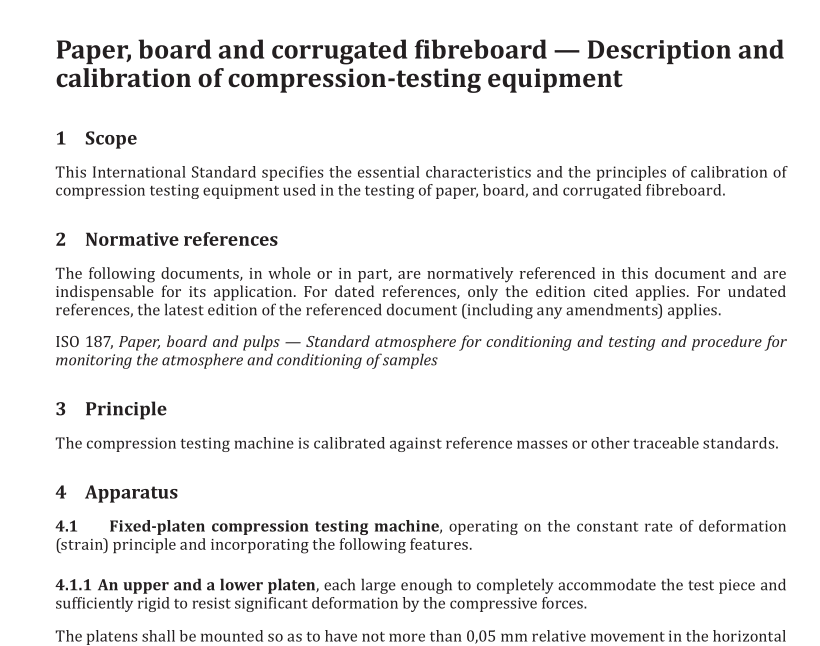ISO 13820 pdf download

ISO 13820 pdf download Paper, board and corrugated fibreboard — Description and calibration of compression-testing equipment
1 Scope
This International Standard specifies the essential characteristics and the principles of calibration of compression testing equipment used in the testing of paper, board, and corrugated fibreboard.
2 Normative references
The following documents, in whole or in part, are normatively referenced in this document and are indispensable for its application. For dated references, only the edition cited applies. For undated references, the latest edition of the referenced document (including any amendments) applies.
ISO 187, Paper, board and pulps — Standard atmosphere for conditioning and testing and procedure for monitoring the atmosphere and conditioning of samples
3 Principle
The compression testing machine is calibrated against reference masses or other traceable standards.
4 Apparatus
4.1 Fixed-platen compression testing machine, operating on the constant rate of deformation (strain) principle and incorporating the following features.
4.1.1 An upper and a lower platen, each large enough to completely accommodate the test piece and sufficiently rigid to resist significant deformation by the compressive forces.
The platens shall be mounted so as to have not more than 0,05 mm relative movement in the horizontal plane and their surfaces shall be parallel to each other, within 0,05 mm per 100 mm of platen surface. The surface of the platens shall be flat to the extent that the lowest and highest points are within 0,05 mm of the average surface.
Some tests require the surface finish of the platen to be such as to prevent slippage of the test piece during the test. Emery cloth, grade 00 or its equivalent (type 240 in Europe, crocus cloth in Canada), secured to the surface of the platens with contact adhesive or with low-compressibility double-sided pressure-sensitive tape (see NOTE), or matte finish of the platen surfaces, or any equivalent means, can be used to achieve this, provided the requirements for parallelism are met.
The emery cloth shall be replaced as soon as any damage is observed. On no account should a knife or other sharp instrument be used to remove the emery cloth or other material adhering to the platens.
NOTE While compliance with ISO 7263 permits emery cloth to be used on the platen surfaces, other test methods do not. With ISO 3037, it is safer to avoid the use of emery cloth. However, it is common practice to use the same tester for tests which do and do not require emery cloth. The possibility of erroneous test results is sufficiently low to allow the use of emery cloth in all ISO test methods in which the use of this compression testing machine is now required, provided that a grade not coarser than 00 is used.
4.1.2 Means of moving one platen towards the other at a constant, controlled speed. Different speeds are standard in different parts of the world, the most typical being (12,5 ± 0,25) mm/min and (10,0 ± 0,25) mm/min. As test values can be impacted by the strain rate of the applied load, it should









